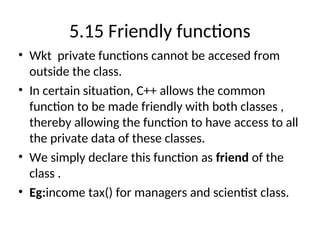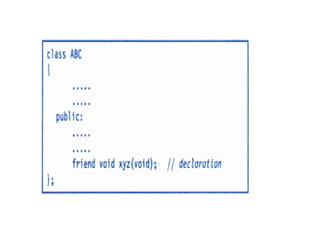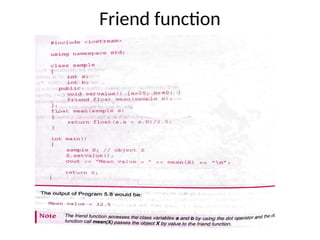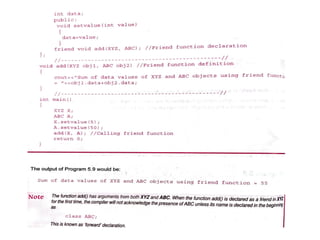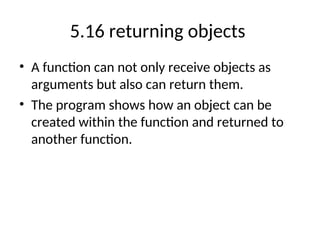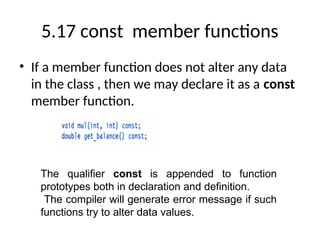APL-2-classes and objects.ppt data structures using c++
- 2. 5.1 C structures • Provide method for packing different data types together • Handling logically related data items • User defined data type with template that serve to define its data properties. • We can create variable of that type using built in type declarations.
- 3. Example of struct Student is the new data type and we declare variable like this Member variable can be accessed by dot or period operator
- 4. • Structures can have arrays pointers and structures itself as members. • Limitations of structure – C doesn’t allow struct datatype to be treated as builtin data type. – They don’t permit data hiding, can be accesed by any function
- 5. 5.2 Classes : extension of structures • In C++ , UD data types are attempted to be treated to be like built in data type, facility to hide data, inheritence-one type can inherit charecteristics from other types. • In, C++, structures can be variables& functions • Keyword struct is omitted • The difference between classes and structures in C++ is that • Stuctures hold only data, and members are public-by default • Classes hold data and functions, members are private by default.
- 6. 5.3 specifying a class • Class specification has 2 parts – 1.class declaration-describes types and scope of its members. – 2.class function definition-describes how functions are implemented. The general form of class declaration is:
- 7. • Private members are accessed only within the class, its default declaration • Public members-outside the class also • The variables declared inside the class are known as data members and functions as member function. • Only member functions can have access to private data members and private functions. • The process of binding data and functions together in a single class type variable is ref to as encapsulation
- 9. A simple class declaration example Getdata(), putdata() can only be used to assign member variables number and cost and display respectively. These functions provide the only access to data members from outside class. This means that data cannot be accessed by any other function that is not a member of the class ITEM.
- 10. Creating objects • Once class is declared we can create variables of that type. Or even more than one variables. Object is an instance of class. We can also create object when class is defined by placing immediately after closing brace as structures.
- 11. Accessing the class members • Format for calling a member function is Example: Similarly
- 12. • Variable declared as public can be accessed by objects directly.
- 13. 5.4 defining member functions Member functions can be defined in two places – 1.outside the class definition – 2. inside the class definition
- 14. Outside the class definition • They are very much like normal functions. • Should have function header and body. • Imp difference: member function incorporates a membership ‘identity label,(tells compiler which class the function belong to), in the header.
- 15. example
- 17. Inside the class definition • Another method of defining a member function is to replace the function declaration by actual definition inside the class. When a function is in a class its treated as inline function. Only small functions are defined inside the class definition.
- 18. 5.5 C++ program with class(class implementation)
- 19. 5.6 Making an outside function inline • We can still make member function inline by using inline in the header line of function definition.
- 20. 5.7 Nesting of member functions • We know that member function of a class can be called only by an object of that class using dot operator. • Exception: It can also be called by using its name inside another member function of same class. – This is known as nesting of member functions.
- 22. 5.8 private member function • A private member function can only be called by another function that is a member of its class. • Even an object cannot invoke a private function using the dot operator.
- 23. If S1 is an object of sample then Is illegal. However function read() can be called by function update() to update the value of m
- 24. 5.9 Arrays within a class • Arrays can used as member variables in a class. The array a[] can be used in the member functions like any other variable. We can perform any operations on it.
- 25. 5.10 Memory allocation for objects • Member functions are created and placed in memory space only once when they are defined as a part of class specification. • No separate memory for members functions as all objects belonging to same class use same mem.fns. • Separate memory locations for objects are required as member variables will hold different values for different objects.
- 27. 5.11 Static data members • A static member variable has certain special charecteristics: They are used to maintain same values common to entire class. Eg: counter that records the occurrences of all objects. Static variable are like inline mem.fns as they as declared in class declaration and defined in source file. While defining , it can be assigned initial value as well.
- 29. 5.12 static member function • A member function which is declared as static has following properties: – It can have access to only other static members(fn/var) declared in the same class. – Can be called using class name(instead of its objects )
- 30. Example
- 31. 5.13 Arrays of objects • Arrays of variables that are of type class are called arrays of objects.
- 32. 5.14 Objects as function arguments • An object may be used as function argument in two ways: – A copy of entire object is passes to the function. (pass by value)-only copy – Only the address of the object is transferred to the function.(pass by reference)-here fn works directly on the actual objects used in the call. So changes will affect actual object- efficient
- 33. Example
- 35. An object can also be passed as argument to a non member function. Such fns can have access to the public member functions only through the objects passed as arguments to it. These functions cannot have access to the private data members.
- 36. 5.15 Friendly functions • Wkt private functions cannot be accesed from outside the class. • In certain situation, C++ allows the common function to be made friendly with both classes , thereby allowing the function to have access to all the private data of these classes. • We simply declare this function as friend of the class . • Eg:income tax() for managers and scientist class.
- 40. Friend function
- 42. Using friend function to add data objects of two different classes
- 44. Shows how to use a common friend to exchange the private values of two classes . The finction is called by reference
- 46. 5.16 returning objects • A function can not only receive objects as arguments but also can return them. • The program shows how an object can be created within the function and returned to another function.
- 49. 5.17 const member functions • If a member function does not alter any data in the class , then we may declare it as a const member function. The qualifier const is appended to function prototypes both in declaration and definition. The compiler will generate error message if such functions try to alter data values.
- 50. 5.18 POINTERS TO MEMBERS








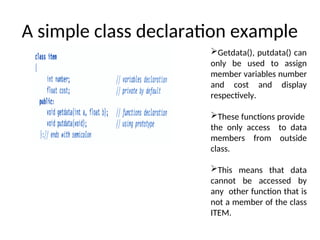

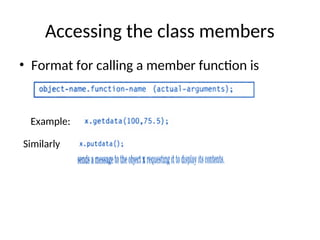
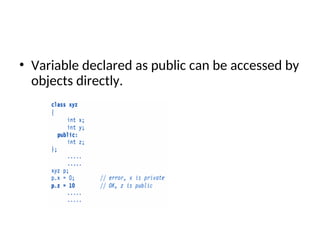




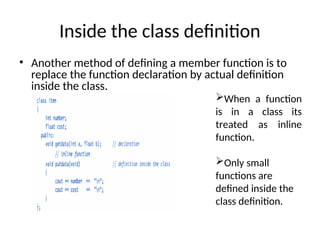






![5.9 Arrays within a class
• Arrays can used as member variables in a
class.
The array a[] can
be used in the
member functions
like any other
variable.
We can perform
any operations on
it.](https://image.slidesharecdn.com/apl-2-classesandobjects-250312032848-47039e72/85/APL-2-classes-and-objects-ppt-data-structures-using-c-24-320.jpg)











